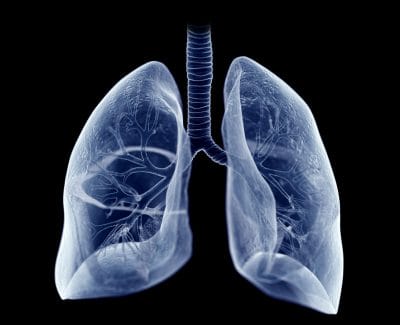Introduction
Cystic fibrosis is often called “CF” for short. CF is a genetic disease, meaning people get it from their birth parents. Genes are tiny pieces of information that tell a person’s cells how to grow and work. Every person gets two copies of each gene, one from each parent. CF is called “autosomal recessive”, meaning that to have the disease, a person needs to get a broken copy of the CF gene from both parents. If a person has one normal and one abnormal copy of the CF gene, they are called a “carrier” and do not have the disease, although they can pass it to their children.
Autosomal Recessive Inheritance. If one parent is a CF carrier (represented by black), then two out of four children will be carriers (50% chance). If BOTH parents are carriers, then one of four children will have the CF disease (25% chance). Remember that these numbers are just odds and your family can be different.
How does CF work?
CF can cause problems in many parts of the body, including the lungs, gut, and sinuses. These places have “glands” that make mucus, a sticky fluid that is very important for staying healthy. When it is working properly, mucus keeps our nose, throat, intestines, and lungs moist and helps trap and get rid of germs and other things we breathe in.
People with CF have genes that make the wrong type of a protein called “CFTR”. Normally, CFTR helps move tiny “chloride” particles across the edge of cells. Cells are the basic building blocks of the body. CFTR is part of a system that gives mucus just the right amount of water and does not make it too thick or thin. The consistency of mucus is very important in places like the lungs and sinuses. In people with CF, mucus is too thick and dry and doesn’t clean out germs and debris.
How CFTR works. Tiny bits of sodium and chloride move across the edges of cells. This keeps mucus in the nose, lungs, and intestines the right consistency. When CFTR doesn’t work, chloride can’t move across the cell, and too much sodium and water is pulled in. The mucus becomes thick and dry, becoming clogged with bacteria and other germs.

Inside the sinuses and lungs are tiny hair-like structures called “cilia”. Cilia are like little paddles, working together to move mucus out of the nose, sinuses, and lungs so that it can be swallowed. In this way, any germs or debris in the mucus get out of the body. Pushing normal thin and watery mucus is much easier than pushing the very thick mucus in CF. In CF, the thick mucus stays in the lungs and sinuses, which become blocked and infected. In the intestines, this causes problems breaking down food.
Most people with CF will have swelling and thick mucus in the sinuses. Bacteria get trapped in the sinuses, causing infection, and nasal polyps often grow due to inflammation. Polyps are watery swellings of the lining of the sinuses that look like grapes. Polyps create even more blockage.
Symptoms
Symptoms are not the same in all people with CF. Newborn babies can have a blockage in their intestines that causes belly swelling and throwing up. Older kids with CF can have problems digesting food and grow less than they should.
Breathing problems are widespread in CF, including cough, wheezing, and a lot of lung and sinus infections. Many patients have large nasal polyps, thick mucus, and infected crusting in the nose and sinuses. This can cause symptoms of sinusitis like trouble with smell, facial pain and pressure, and stuffiness. Other symptoms of sinus problems are post-nasal drip, constant need to clear one’s throat, and bad breath.
Diagnosis
Different tests can be used to diagnose patients with CF. CT and X-rays can be helpful to check for problems in the lungs and sinuses. Breathing tests (called “pulmonary function tests” or “PFTs”) are used to see how well the lungs are working. Lab tests can include checking for CF genes and “sweat chloride testing”. The sweat chloride test looks for high salt levels in sweat that come off of the skin, which happens in CF. Genetic testing can also be an option for family members of CF patients to see if they may be carrying the abnormal gene.
Management
There is no cure for CF, but treatment can help people live full lives. CF affects many parts of the body, so patients often need a team of doctors and other specialists. This team is usually led by a lung doctor (“pulmonologist”) and also may have an ear, nose, and throat surgeon (“otolaryngologist”).
There are many ways to treat CF. Medicines, including antibiotics, can be given by mouth, through an IV, or breathed into the nose and lungs. Some medicines help to break down the thick mucus. Chest therapy helps loosen mucus plugs and other medicines can help with digestion. Some patients receive lung and other organ transplants.
For CF patients with sinusitis, high-volume saline rinses help clear thick mucus and can deliver medicines like antibiotics and steroids straight to the sinuses.
Sinus surgery can help improve sinus symptoms in people with CF. In endoscopic sinus surgery (ESS), the surgeon removes polyps and mucus and opens the sinus cavities widely. This allows saline and medicines to reach the sinuses further and helps mucus drain out.
New medications like Ivacaftor can make a big difference for some people with CF. These drugs work directly on the broken CFTR protein that causes CF disease in some patients. Researchers are working hard to find other new ways to treat CF.

